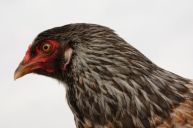The Cream Legbar breed is a British chicken breed almost a hundred years old, but it is still relatively rare in the United States. This rare, crested chicken lays sky-blue eggs, loves to free-range, and is friendly and calm. It's only been in the country for a few years, so chicken owners are still discovering all of the perks that this breed has to offer.
If you're looking to expand your backyard chicken flock, a Cream Legbar might be the perfect addition. Not only is this chicken ideal for families to raise, but it will add some fun egg color variety to your flock.
Origin of the Cream Legbar

Photo via Daphne Cybele
The Cream Legbar is a cross between Barred Plymouth Rocks and Brown Leghorns, with some Araucana and Gold Campine genes. The Araucana genes give the Cream Legbar its funny little crest and the sky-blue or pale green eggs; the Leghorn contributed its excellent egg production (160 to over 200 per year); the Barred Plymouth Rock genes contribute the ability to easily tell roosters from hens when the chicks hatch.
1930's researchers Reginald Crundall Punnett and Michael Pease at the Genetical Institute of Cambridge University in Britain had a goal in mind with the Cream Legbar: to create a chicken with excellent egg-laying ability and a clearly distinct and reliable difference between roosters and hens that could be seen in baby chicks on the day of hatch (a breed trait known as "auto sex").
Cream Legbar Characteristics
According to the Royal Breeds Survival Trust, Cream Legbars are an autosexing breed of chicken. This means that they are immediately able to be sexed within a day of hatching. Female chicks are born with dark and light stripes on their bodies, while male chicks are born with a lighter coat and a yellow spot on their heads. These distinctive characteristics make it easy for breeders to immediately determine which chicks are male and which are female, making for a more efficient breeding operation.
Once grown, these chickens are slender and elegant. The cockerel's (males) have a cream-colored neck and saddle, as well as a grey chest, legs, and wings. The Cream Legbar hens also have cream-colored necks, but their chests are salmon-colored and their bodies are grey.
These chickens are active, but eat less food than other breeds. The females only rarely go broody, so breeding and hatching legbar eggs is often done with an incubator.
The Cream Legbar as a Recognized Breed
The British Poultry Club formally recognized the Cream Legbar in 1958. It nearly died out in the seventies but has come back due to a renewed interest in blue egg layers.
The American Poultry Association (APA) does not yet formally recognize the Cream Legbar breed. The breed is still fairly new to poultry owners in America—it was as recent as 2010 that Greenfire Farms began to import breeding stock, and they claim to be the only supplier with legally-imported, pure-breed Cream Legbars. They continue their breeding program with stock from Jill Rees, award-winning Cream Legbar breeder of England.
If you search, you can find multiple suppliers of Cream Legbar chicks and eggs in the United States.
The Cream Legbar Club was established in 2012 in the United States to preserve and promote the breed in this country and hopes to get the breed eventually recognized. Their draft breed guide is here.
So, if you would like to add a rare blue-egg-layer with a fluffy crest to your flock, consider the friendly, calm, free-ranging Cream Legbar!
Why do you have or want Cream Legbar chickens? Let us know on the Wide Open Pets Facebook page!
This post was originally published on September 25, 2019.




